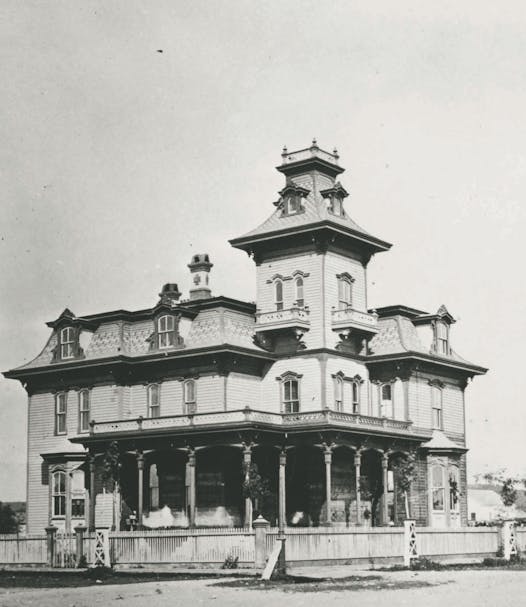So many large homes are concentrated along and around Summit Avenue in St. Paul that it is easy to assume it has always been the city's prime mansion district.
But in the city's early days, the largest collection of mansions stood in what today would seem an unlikely place — Lowertown.
Well, not what most people now think of as Lowertown, with its warehouses-turned-apartments and trendy bars and restaurants. The early mansion district was farther east, past the intersection of Interstates 94 and 35E, in an area north of E. 7th Street.
The area is now occupied by a mix of industrial and office buildings as well as the Ramsey County jail and the St. Paul Police Department headquarters, but it once was almost entirely residential. At the time, it was an attractive place to live because it offered relatively high ground with views of the Mississippi River, it was close to downtown and bordered the shallow green valley of Trout Brook.
Unlike Summit Avenue, which sat atop steep bluffs, Lowertown offered easy access to mass transit. In 1872, one of the city's first horsecar lines was built along E. 7th, later replaced by a cable car line before streetcars were introduced around 1890.
By the mid-1880s, the neighborhood was all but filled out, its streets lined by hundreds of single-family homes, duplexes and row houses, mixed with a few churches and commercial structures.
At least 30 mansions, including many of the city's most palatial homes, were scattered throughout the neighborhood. Virtually all of them were built before 1880. Most were fairly standard examples of the Italianate or French Second Empire styles, which were popular at the time. A few of the earliest homes, including Bartlett Presley's 1856 mansion on E. 8th Street, were Greek Revival.
Mansion row
A small wedge of greenery called Lafayette Park, located near today's intersection of Grove Street and Lafayette Road, served as the neighborhood's centerpiece. The park included the requisite fountain, along with walkways and benches.
Woodward Avenue, a three-block-long street just south of Trout Brook, was home to many of the neighborhood's most notable mansions. Tavern owner Jacob Bass built the first great house on Woodward in 1857. The 16-room stone mansion, a blend of Greek Revival and Italianate influences, was probably the largest and costliest home of its day in St. Paul. Bass sold the house in 1864 to Henry Sibley, Minnesota's first governor, who lived there until his death in 1891.
Just next door, pioneer banker Horace Thompson built a towered Italianate mansion in 1860. Businessman and later philanthropist Amherst Wilder also occupied a home on Woodward before commissioning a much more splendid mansion on Summit Avenue in 1887. Dennis Ryan, the man behind St. Paul's now long-gone Ryan Hotel, was another of the avenue's more prominent residents.
Railroad magnate Elias Drake, lawyer George Becker and businessman John Merriam were other members of St. Paul's elite who once owned mansions in the vicinity. James J. Hill also resided for a time in the neighborhood, building one of its last mansions, on Canada Street, in 1877.
Short-lived luxury
The Lowertown mansion district had a surprisingly short life, largely because of changes brought on by railroad expansion.
By the late 1880s Trout Brook Valley, which offered an easy grade up from the Mississippi River, was one of the state's most crowded and heavily used railroad corridors. The trains generated noise and smoke and also attracted industry, and the neighborhood quickly lost its cachet as a residential district.
The big mansions on Woodward were all gone by the early 1900s, with their residents in many cases relocating to new homes on Summit. In 1903 the St. Paul Pioneer Press reported "not much was left to Lower Town but the memories of departed grandeur."
A year later, the same tornado that knocked down a portion of the Smith Avenue High Bridge tore through Lowertown, causing significant damage and leading to further decline.
In 1917 there was yet another transformation, courtesy of the Great Northern Railway, which cleared away more than 250 houses to create a new freight terminal at 8th and Olive streets. The final blow came in the 1960s, when the western and southern portions of the neighborhood were leveled to make way for freeways.
Today, not a single house exists in what was for a time St. Paul's finest residential neighborhood. Lafayette Park is gone, as well (the site is now a parking lot) and even Woodward Avenue has all but vanished, surviving only as a dead-end nub off Payne Avenue near E. 7th Street.
Although other mansion districts have come and gone in the Twin Cities, the transformation of the old Lowertown neighborhood remains perhaps the most stunning example of its kind, demonstrating just how completely the urban fabric can change over time.
Larry Millett is an architecture critic and author of 14 nonfiction books and eight mystery novels. He can be reached at larrymillett.com.
What Winnie the Pooh and Mickey Mouse can tell us about the public domain and remix culture
Artist and curators refuse to open Israel pavilion at Venice Biennale until cease-fire, hostage deal
Salman Rushdie's 'Knife' is unflinching about his brutal stabbing and uncanny in its vital spirit
ABBA, Blondie, and the Notorious B.I.G. enter the National Recording Registry




